Operation Overlord is sometimes thought, albeit incorrectly, to refer solely to the Normandy landings on 6th June 1944 – or “D-Day” as it is more familiar to many. Overlord was, in fact, a much broader plan. Documents from SHAEF (Supreme Headquarters Allied Expeditionary Force) states the aim of Operation Overlord was to “…secure a lodgment area on the Continent from which further offensive operations can be developed. The lodgment area must contain sufficient port facilities to maintain a force of some twenty-six to thirty divisions, and enable that force to be augmented by follow-up shipments from the UNITED STATES and elsewhere of additional divisions and supporting units at the rate of three to five divisions per month.”
You are about to embark upon the Great Crusade, toward which we have striven these many months. The eyes of the world are upon you.
- General Dwight D. Eisenhower, commander Supreme Headquarters Allied Expeditionary Force (SHAEF)
Operation Neptune, in fact, was the name given to the assault phase of Operation Overlord. This included not only the amphibious sea crossing of the English Channel, but also included the airborne assault. Operation Neptune also encompassed the positioning of the Mulberry Harbors and the laying of the Pluto pipelines to deliver fuel from England to the troops in France. Operation Neptune officially concluded on 30th June 1944.

The original plan for the Allied landings drawn up by Chief of Staff to Supreme Allied Commander (COSSAC) – devised by Lieutenant General Frederick E. Morgan and his team – called for an invasion by three divisions with a further two divisions in support. When Generals Eisenhower and Montgomery first saw the plan in December 1943 they insisted that the assault be increased to five divisions attacking form the sea with three airborne divisions landing on the flanks of the invasion area. These revisions by Eisenhower (commander of SHAEF – Supreme Headquarters Allied Expeditionary Force) and Montgomery (commander of 21st Army Group – the land assault forces for the invasion) shaped how we see the assault area today – the 50-mile stretch of coast between the Cotentin Peninsular and the Orne River, with the drop zones of the airborne divisions just inland from the coast on the western and eastern flanks.

The westernmost of the beaches are Utah Beach and Omaha Beach – both assaulted on the morning of 6th June by American forces. Moving eastwards is the British Gold Beach, followed by Juno Beach where the Canadian forces landed. The easternmost is Sword Beach, where British forces landed along with 177 Free-French commandos. In the west, in the area behind Utah Beach, landed the American airborne dropped in the early minutes of the 6th June forces of the 82nd Airborne and 101st Airborne Divisions, followed up by glider-borne troops. Whilst in the east landed the paratroopers and airborne infantry of the 6th Airborne Division landed to the south and east of Sword Beach.
- Utah Beach Landing Zone
- Omaha Beach Landing Zone
- Gold Beach Landing Zone
- Juno Beach Landing Zone
- Sword Beach Landing Zone
The first invasion force of D-Day was a small group of SAS (Special Air Service) commandos who landed near Saint-Lô. The first of these landed at 00:11hrs, with the rather incongruous mission that included playing battle sounds, shouting and gunfire, through large speakers. They were part of Operation Titanic, just one of many deception missions carried out across Normandy that night as part of the wider Operation Fortitude deception plan aimed at causing confusion amongst the German forces.
Elsewhere in Normandy, other elements of Operation Titanic included the dropping 500 dummy parachutists (known as “Rupert” by the British and “Oscar” by the Americans), from Allied aircraft. These were constructed of simple hessian cloth bags sewn together. Upon landing, the 3-foot tall dummy, which contained a small explosive charge, was designed to catch fire and burn – preventing the enemy from discovering that it was a deception.
Just a few minutes after the SAS teams dropped into Normandy, pathfinders of the US 101st Airborne division began landing. Their aim was to quickly erect a series of lights and beacons to help guide the main airborne assault forces to the correct locations. Mis-drops due to low cloud and heavy anti-aircraft fire; damaged equipment and the loss of several aircraft enroute containing other necessary hardware meant the pathfinder operation was a seriously impeded. However, because of the mis-drops it did succeed in making the German’s think there were greater numbers of paratroopers than there actually were.
The night before D-Day, the sky was black with planes. The roar of those planes! Nobody could sleep. Everybody was out of their beds and looking up.
- June Marin, Civilian in Portsmouth
At the same time at the other end of the invasion area the British coup de main force consisting of five Horsa gliders with men from the 2nd Battalion, Oxfordshire and Buckinghamshire Light Infantry landed near the bridges over the Orne River and Caen Canal (a sixth glider was released from its tow plane too late and landed 12km away). Their mission was to capture and hold these bridges until re-enforcements from Sword Beach could arrive later in the morning. The first glider, piloted by Staff Sergeant Jim Wallwork, touched down just meters from the bascule bridge over the Caen Canal (now known as Pegasus Bridge). The coup-de-main force, commanded by Major John Howard, succeeded in capturing both bridges within 15 minutes.
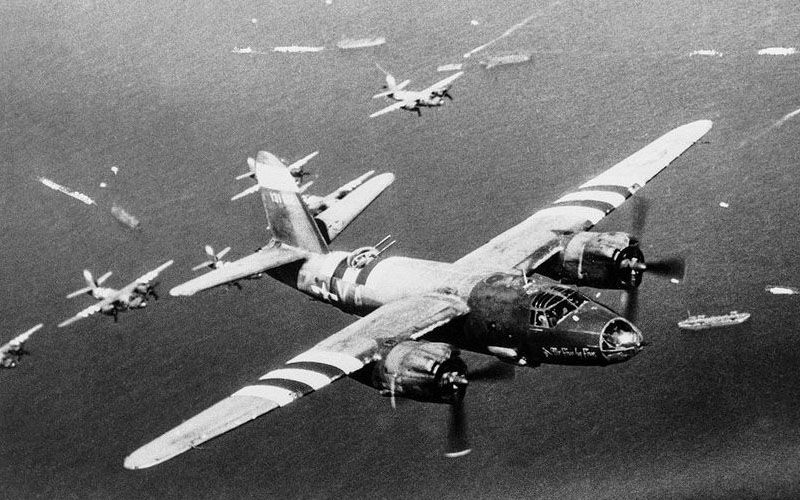
The Invasion was now beginning to gather momentum, and Tuesday 6th June 1944 was still less than one-hour old.
RAF aircraft had been dropping more pathfinders, this time British, to the east. The objectives of the British airborne landings of Operation Tonga were ambitious and wide ranging. In addition to the capturing of the Orne River and Caen Canal bridges by the glider assault, other elements of the 6th Airborne Division were dropped over Ranville, Merville, Trouffeville and Troarn. Their aim was to take out the German battery at Merville to the south-east of Cabourg, destroy bridges and occupy the crest of Troarn to prevent the arrival of German reinforcements during the landings. The British airborne drops will be scattered far and wide, hampering but not preventing their main objectives from being achieved.
At 01:30hrs Men from the 9th Parachute Battalion, part of the 6th Airborne Division, rendezvous a mile east of Merville battery but only 150 of 600 make it because the drop has dispersed them so widely.
Back towards the western edge of Normandy in the flooded marshes and small villages behind Utah Beach, the first American paratroopers of the 101st and 82nd Airborne Divisions have jumped from their C-47 Skytrain aircraft. Drops were scattered widely and chaos ensued with drop zones being missed by many miles in some cases. This was due to a number of factors including flak, cloud cover, a lack of navigators on sixty percent of the aircraft and poorly marked drop zones. Small groups of paratroopers did begin to form up and sporadic engagements with the German forces took place across the Normandy countryside. The specific missions of the two airborne divisions were to block approaches into the vicinity of the amphibious landing at Utah Beach, to capture the causeway exits leading inland from the beaches, and to establish crossings over the Douve River at Carentan to assist the U.S. V Corps in merging the two American beachheads.
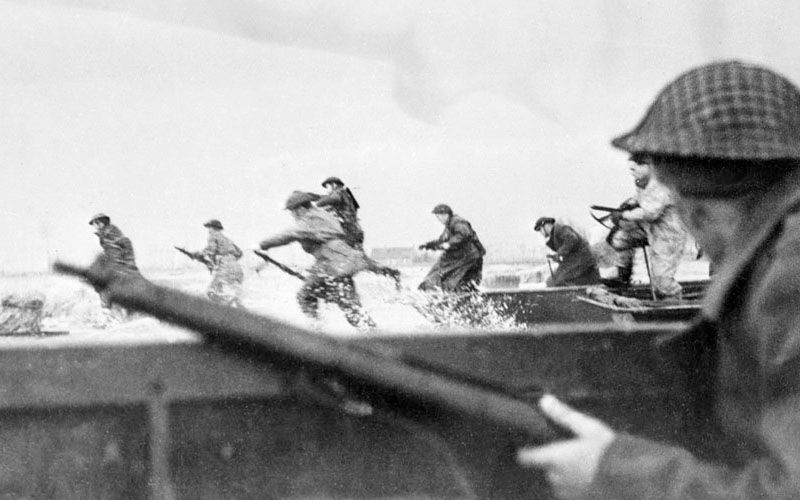
Many paratroopers drown in the fields flooded by the Germans, whilst some unfortunate members of the 82nd Airborne are dropped directly into the town square of Sainte-Mère-Église where they are gunned down whilst in their harnesses by German soldiers. One paratrooper, Private John Steele, will famously have his canopy caught on the church steeple as he descends. Stranded for two hours above the square, he witnessed many of his friends mowed down by German gunfire before their feet hit the ground.
The parachute drops will be followed with glider landings bringing in more troops, headquarters companies, heavier weapons, signals and surgical units, vehicles, communications and two anti-aircraft battalions.
One of the Allies’ many deception plans was now underway. Operation Taxable was being executed by RAF aircraft of 617 Squadron near Cap d’Antifer. Instead of bombs, however, aircraft were dropping strips of metal foil, known as “window”. It was designed to fool German radar operators into believing that they were looking at large-scale activity. Operation Taxable also had the task of laying mines. Similarly, Operation Glimmer involved planes of 218 Squadron near Boulogne-sur-Mer also dropping “window” – designed to reinforce idea that invasion would happen at Pas-de-Calais. In the waters below the aircraft, small boats towed radar reflector balloons and simulated the radio traffic expected of a large fleet to enhance the ruse. Operation Glimmer some response from German forces who dispatched reconnaissance aircraft to investigate the “fleet”.
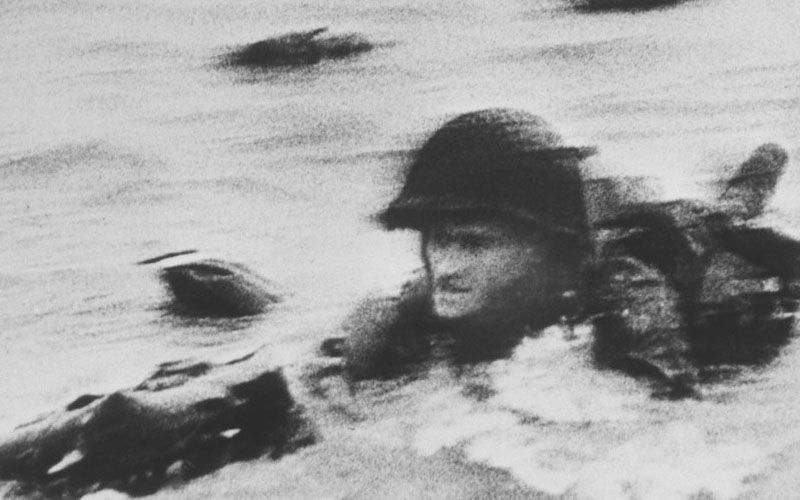
In England, the first wave of bombers took to the skies at 02:00hrs heading to France to attack the German defenses; whilst at 02:51hrs off the coast of Normandy the USS Ancon, a former ocean liner, dropped her anchor 11 miles from the beach. She was the flagship of Assault Force “O” for Omaha Beach. Forty-five minutes later, troops bound for the beaches codenamed Omaha and Utah begin transferring from the assault ships which have carried them across the channel in to the small landing craft which will deliver them to the shores of occupied France.
By 03:00hrs the ships of Operation Neptune have been arriving in their assigned position for several hours. The first assault units are now being transferred from the larger vessels to the LCAs, LCVPs and other landing craft the will storm the beaches. The first German naval observers begin to report the presence of the Allied task force. Aboard one of the ships, an attack transport named USS Samuel Chase, is Robert Capa. He is an American war photographer and would later land with the first wave of troops at Omaha Beach.
Back in the British sector about 20 miles away, Georges and Thérèse Gondrée, proprietors of the Café Gondreé beside the bridge over the Caen Canal, realise the soldiers near their home are British and they open their doors to greet them. It is often cited as the first house to be liberated in France.
Nearby, at 04:00hrs, the assault on the Merville battery begins despite the attacking force having only 150 of its planned 700-man strength and almost none of its heavy weapons. Speed and violence replace missing firepower and the battery was taken. At 04:45hrs, just minutes before HMS Arethusa is due to open fire on the battery, the commander of the raiding force Lt. Col. Terence Otway fires a yellow signal flare to communicate a successful mission. Of the 150 paratroopers that storm the battery, some 70 were killed in the assault. The site was equipped with old 75mm guns and not the 150mm guns intelligence had reported.
In the American airborne sector, soldiers of 3rd Battalion, 505th Parachute Infantry Regiment of the 82nd Airborne Division captures the town of Sainte-Mère-Église. It is the first town to be liberated in France.
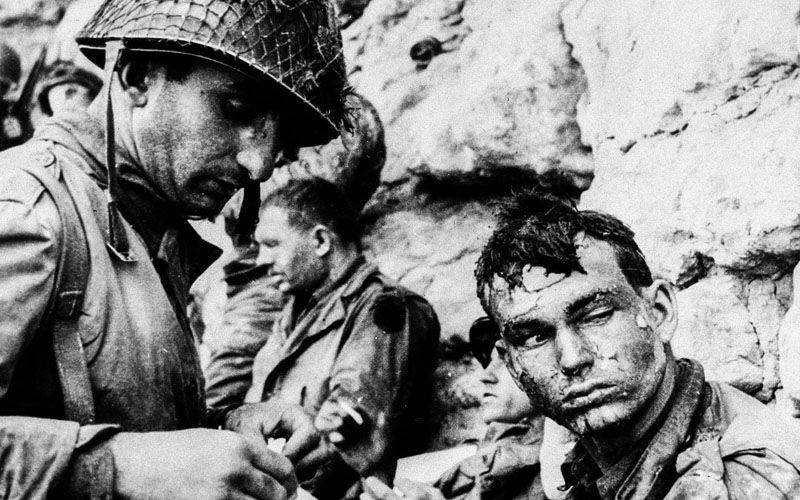
By this time, reports of the invasion are now spreading through the German commands across Normandy. Field Marshal von Rundstedt, commander of the German army in France was hearing reports from Normandy of fighting but still believed an invasion was aimed at Pas-de-Calais. The 21st Panzer Division could be mobilized but Hitler was asleep at Berchtesgaden and there are instructions he should not be woken. The Panzers can only be released with the Führer’s express authority.
The first men to invade from the sea have actually already landed. Three miles from the coast of Utah Beach, 132 men from the 4th and 24th cavalry squadrons of the US 4th Cavalry Group under Lt Col Edward Dunn have landed on the Îles Saint-Marcouf. It is thought the island may contain German artillery and observation posts. No enemy were encountered on the island but some of the soldiers were caught in a minefield, and nineteen were killed or wounded.
At the same time as Lt. Col. Otway is sending up his signal flare, two midget submarines, known as “X-Craft”, surface twenty miles apart just one mile from the coast. The two submarines, X20 and X23, each with a crew of five, have been positioned here and submerged for 74 hours. Upon surfacing their crews raise their 18ft telescopic masts with strobe lights and radio beacons which now mark the eastern and western extremities of the British and Canadian Beaches to the approaching fleet. In the skies above, more than a thousand aircraft of the Royal Air Force are dropping some 6,000 tonnes of bombs on the coastal defenses along the Normandy coast.
General von Rundstedt orders the 12th SS Panzer Division “Hitlerjugend” and Panzer-Lehr to move immediately to Calvados.
As we reached Omaha Beach, all 40 aircraft dropped their bombs. More than 100 tons of bombs exploded in a few seconds. This was the only mission over Europe when I felt the concussion of our own bombs.
- Henry Tarcza, 8th Air Force
Allied naval bombardment commenced at 05:30hrs, with seven battleships, 23 cruisers and 103 destroyers pounding the German defenses along the shoreline. Three German torpedo boats from Le Havre appear through the Allied smokescreen near Sword Beach. The boats launch 18 torpedoes and quickly disappear. A Norwegian destroyer, HNoMS Svenner, is hit by a torpedo meant for HMS Warspite. She sinks with the loss of 33, although 185 crew members are rescued.
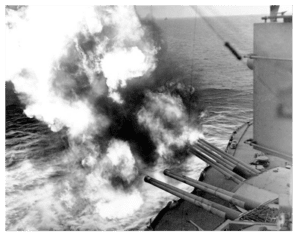
There was now frenetic activity all across the invasion front. The Allied warships bombarding targets behind along the coast to “soften up” the defenses before the first waves of troops were taking return first from German coastal batteries. Overhead, British and American bomber aircraft continue to pound the coast, albeit with mixed levels of accuracy.
Daybreak was at 05:58hrs, and two minutes later the BBC broadcasts a message from General Eisenhower to the people of Normandy. It said “The lives of many of you depend on the speed with which you obey. Leave your towns at once – stay off the roads – go on foot and take nothing with you that is difficult to carry. Do not gather in groups which may be mistaken for enemy troops.”
H-Hour was just 30 minutes away. Assault landing craft were already heading in towards Utah and Omaha Beaches carrying men of the US VII Corps and V Corps. The British and Canadian landings to the east would take place an hour later due to the difference in tidal conditions.
At 06:23hrs the first Landing Craft Tank (Rocket), or LCT(R), began launching their salvos of 127mm rockets at German positions. The LCT(R) were converted British Mk 3 LCT (Landing Craft, Tank). Their fixed 45-degree, forward facing launchers would send almost 40,000 rockets towards the five invasion beaches at targets ashore – over the heads of the of the first assault waves approaching the beaches. The intended task of cratering the beaches and destroying obstacles and mines had only limited effect.
At 06:30hrs, General Alfred Jodl at Oberkommando der Wehrmacht (OKW), the German Armed Forces High Command, cancels General von Rundstedt’s earlier orders to the 12th SS Panzer Division “Hitlerjugend” and Panzer-Lehr – deciding instead to wait for Hitler to wake up.
The naval bombardment of Utah and Omaha Beaches ceases as the first waves approach shore. The aerial bombardments of the German defenses at Omaha have been particularly ineffective, with many bombs falling too far to the south. The defensive positions still pose a potent threat to the assaulting American troops. In landing crafts are Americans of the 1st and 29th Divisions headed for a four-mile front at Omaha Beach and soldiers of 4th Division headed for Utah Beach.
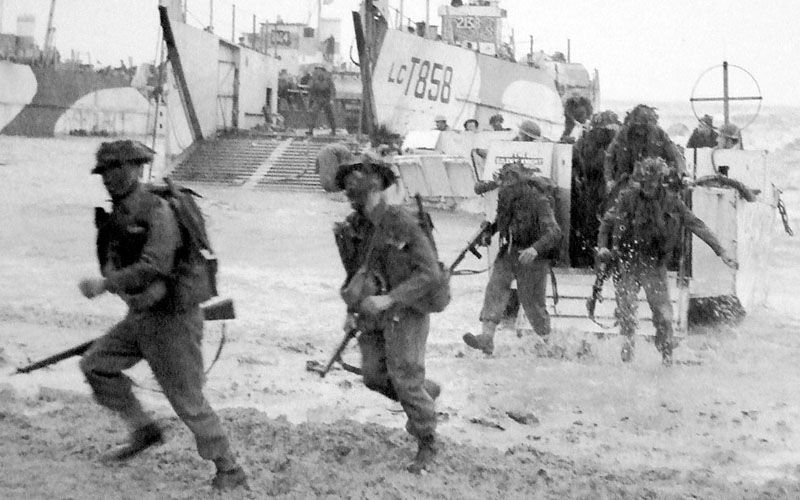
Many of the amphibious DD tanks (for “Duplex Drive”) intended to come ashore with the first wave on Omaha Beach have sunk in the 2-metre swells after being launched too far from shore. At H -6 the tanks of the 743rd Tank Battalion were dropped directly onto Omaha Beach from their landing craft. They were a few minutes late but, as planned, still arrived ahead of the first wave of soldiers.
Strong tidal currents off Utah Beach caused the first wave of twenty LCVPs of 2nd Battalion, 8th Infantry Division to unwittingly deviate 1.8km to the south of their intended target. This fortuitous error saves lives as the area is less heavily defended than their intended destination. When General Theodore Roosevelt of 4th Infantry Division lands he decides that follow up forces should head for this new location. The second wave lands at Utah Beach at 06:35hrs, followed by 28 of the planned 32 DD tanks of 70th Tank Battalion which arrive safely but a late due to a strong headwind.
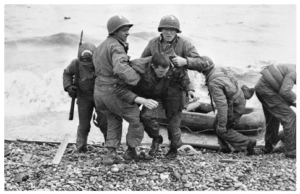
At Omaha Beach things do not go as well. Ineffective aerial and naval bombardments had left the German defenses relatively intact and the entrenched forces were able to lay down murderous gunfire on the soldiers of 116th Regiment of the 29th Infantry Division as they come ashore. The first wave at Omaha comprised around 1,450 soldiers distributed amongst 36 landing craft. As infantry disembarked from the landing craft, they often found themselves on sandbars 45 to 90 meters out. To reach the beach they had to wade through water sometimes neck deep. They still had almost 200 meters to go when they did reach shore. Many of those that made it to the shingle below the bluffs did so at a walking pace because they were so heavily laden.
Robert Capa who arrived aboard the USS Samuel Chase lands with the first wave of troops on Omaha Beach. While under constant fire, Capa spent one-and-a-half hours ashore, taking 106 photographs. The four rolls of film were couriered to the London office of LIFE Magazine, however, all but eleven shots were destroyed in a photo lab accident. The eleven blurred and grainy prints that survived were included in LIFE Magazine’s issue of 19th June 1944 and remain some of the most iconic images of D-Day.
Whilst Berlin Radio made the announcement that paratroopers were landing in France and that an E-Boat had attacked and sunk a destroyer, along the coast from Omaha Beach in the Anglo-Canadian sector, bombing over Gold beach and west of Juno begins as 385 B-17s of the 1st Bombardment Division strike coastal batteries between Longues-sur-Mer and Courseulles-sur-Mer. Meanwhile 322 B-17s of the 3rd Bombardment Division hit batteries and defenses between Bernières and Ouistreham to cover the east of Juno beach and Sword beach.
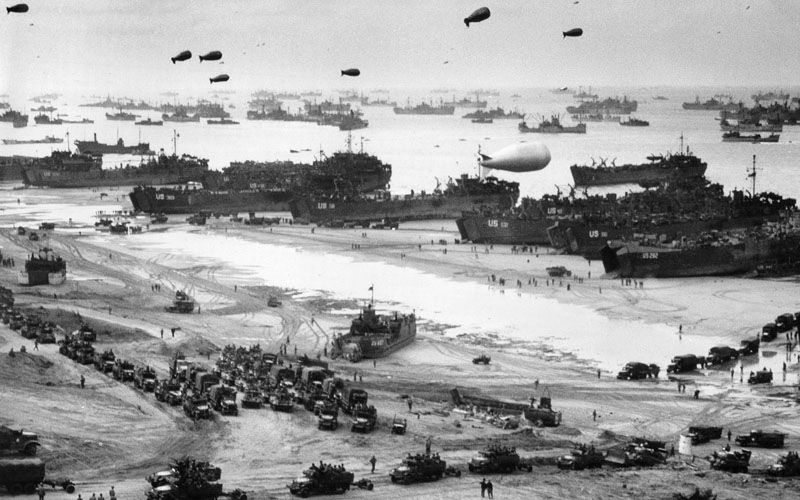
At 07:10hrs, an assault group of 225 men of the US Army 2nd Ranger Battalion led by Colonel James E. Rudder attack the 100ft cliff face at Point-du-Hoc. Atop the cliff sits a German coastal battery which, it is believed, can rain down fire on both Utah Beach to its west and Omaha Beach to its east. Amongst their specialist equipment are extendable ladders borrowed from the London Fire Bridge and rocket-propelled grappling hooks and rope ladders. After fierce fighting the gun emplacements will be taken, but found to be empty. The Germans had moved the guns but they were found in a nearby field and destroyed later in the day. The Rangers continued to fight with Germans forces atop Pointe-du-Hoc for 36 hours, after which only 90 Americans emerged unscathed.
At 07:25hrs, British troops of the 3rd Infantry Division began landing at Sword Beach against stiff German resistance. Led by Major General Tom Rennie, their aim is to liaise with the 6th Airborne and the 3rd Canadian Infantry Divisions to take Caen and the Carpiquet aerodrome by nightfall.
Further west, the men of the British 50th Infantry Division came ashore at Gold Beach. Their mission, under the command of Major General Douglas Graham, is to establish a beachhead between Arromanches – important for the deployment of the artificial Mulberry harbor – and Ver-sur-Mer, then head to Bayeux to cut the road to Caen. After initial resistance, progress was good with relatively few casualties. By the end of the day, 24,970 men will have landed with 413 casualties.
After several hours without a decision, and with Hitler still asleep, General Edgar Feuchtinger unilaterally orders his 21st Panzer Division to move on the eastern beaches at 07:40hrs.
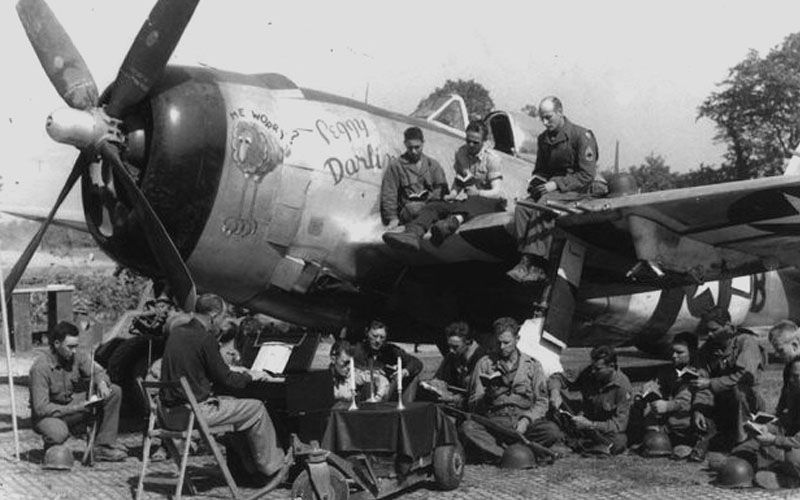
In between the two British sectors, the Canadian 3rd Infantry were due to start landing at 07:35hrs at “Mike” sector and 07:45hrs at “Nan”. Due to heavy seas, the landing was delayed by ten minutes at each, and this resulted in the slightly higher tide and a landing closer to the beach obstacles and mines. The LCTs carrying the field artillery were forced to adjust course to avoid landing too early whilst the LCTs carrying DD tanks were forced to break off their advance. The seas proved too rough to launch the DD tanks, so they were ordered to deploy from the LCTs several hundred yards out from the beach.
On Omaha Beach, many troops were now leaderless and terrified. Survivors who had managed to reach the top of the beach were huddling together. Some tanks had made it ashore and were firing on German positions and providing cover for troops. German soldiers at strongpoint Wn 70 report the breakthrough of six American tanks, three of them at the Wn 66. At 08:25hrs, the strongpoint Wn 62 is overrun by American soldiers, whilst Wn 61 is attacked from both the front and the rear. German radio communication to Port-en-Bessin were down.
General Eisenhower authorized the release of an announcement that confirmed the start of the invasion at 09:00hrs, and thirty minutes later, the voice of John Snagge of the BBC broadcasted the content of “Communiqué No. 1” to the nation. It read simply “Under the command of General Eisenhower, Allied naval forces, supported by strong air forces, began landing Allied armies this morning on the northern coast of France.”
Across the Channel, watching the American landings from aboard the cruiser USS Augusta, General Bradley observed the carnage taking place at Omaha Beach. He considered evacuating the troops or diverting follow forces destined for Utah Beach.
The Free-French commandos, under the leadership of Philippe Kieffer, who had landed at Sword Beach alongside the British, liberate the casino at Riva Bella. Over the next half an hour, Hermanville behind Sword Beach and La Riviere behind Gold Beach would also be liberated. At the opposite end of the invasion front, American troops at Utah Beach had cleared it of all German forces.
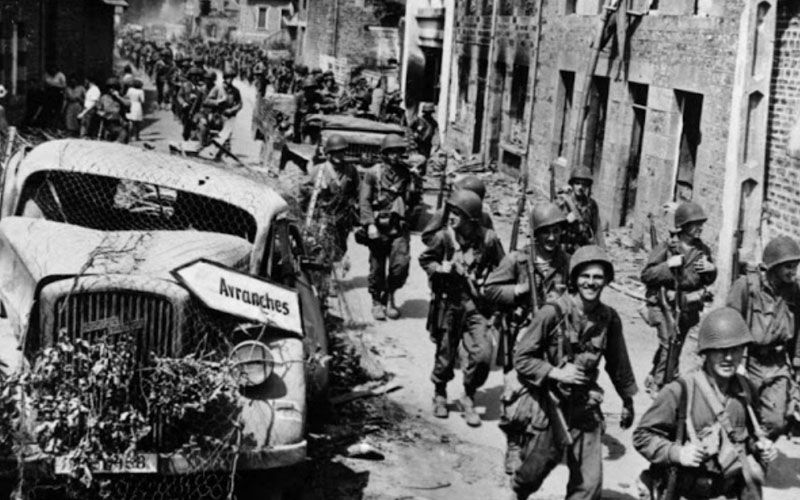
At Omaha, by 10:18hrs a number of destroyers and smaller craft moved in close to shore as they desperately tried to provide cover for the men at Omaha who seemed in a perilous situation. There were, in theory, five exits from the beach – a paved road leading to Vierville-sur-Mer, two dirt roads leading to Colleville-sur-Mer and Saint-Laurent-sur-Mer, and two dirt paths – but given the level of fire the only practicable way out was to scale the cliffs as the US Rangers had done intentionally at Pointe du Hoc.
Two sorts of people are going to stay on this beach, those who are dead and those who are going to die. Let’s get the hell out of here!
- Colonel George Taylor, Commander 16th Infantry Regiment, Omaha Beach (address to his men)
At 10:45hrs, the German 21st Panzer Division received orders to attack between Bayeux and Caen. Along the coast in the Canadian sector, Major General Rod Keller, General Officer Commanding the 3rd Canadian Infantry Division, sent a message to SHAEF which read: “Beach-head gained. Well on our way to our immediate objectives”. By 11:00hrs Canadian forces had captured the town of Bernières-sur-Mer.
Despite progress it was becoming clear on the ground that the plan to take Caen from Sword beach by nightfall will not happen. The British soldiers of the South Lancashire Regiment still held Hermanville but were awaiting tank support from the Staffordshire Yeomanry before they could advance further.
In the British sector, inland from Gold beach, the assault on Le Hamel was proving bloody and would last until late afternoon, with the support of the 147th Field Regiment, Royal Artillery.
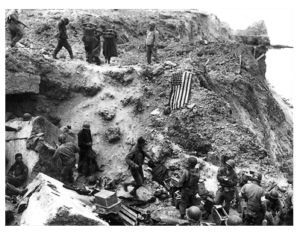
Soldiers from the US 4th Infantry Division advancing inland from Utah Beach were able to link up with paratroopers of the 101st Airborne Division at about midday near the town of Pouppeville. At the same time back in England, the Prime Minister, Winston Churchill, was addressing the House of Commons. He told them: “I have also to announce to the House that during the night and the early hours of this morning, the first of the series of landings in force upon the European Continent has taken place…An immense armada of upwards of 4,000 ships, together with several thousand smaller craft, crossed the Channel. Massed airborne landings have been successfully effected behind the enemy lines, and landings on the beaches are proceeding at various points at the present time…So far the Commanders who are engaged report that everything is proceeding according to plan. And what a plan! This vast operation is undoubtedly the most complicated and difficult that has ever taken place.”
The Germans were still holding 1st Battalion of the Hampshire Regiment at bay outside Le Hamel. The forces of 50th Division had pushed inland four miles towards the town of Creully. Canadian and British Commando had advanced through St Aubin and Courseulles before pushing four miles inland, although they were meeting frequent pockets of resistance. The Royal Marines of 47 Commando had moved west four miles to take Port-en-Bessin and close the gap with the US forces at Omaha.
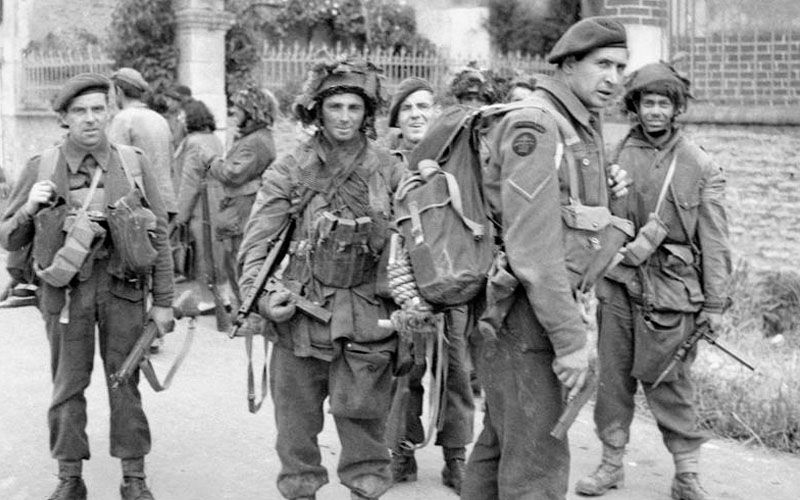
Shortly before 13:00hrs, accompanied by his piper Bll Millin, Lord Lovat and his Commandos of the 1st Special Services Brigade arrive at approach the Bénouville bridges to relieve Major John Howard’s 2nd Oxfordshire and Buckinghamshire Light Infantry. Georges Gondrée, emerges from the Café Gondreé with champagne for Lovat, but is waved away with the words “I’m working”.
At 13:18hrs, reports from Omaha advised that some German strongpoints had been taken, including strategic fortification Wn72 with its 88mm and 50mm guns – helping to open the route to the village of Vierville-sur-Mer. By half past, the first troops finally start moving inland, and a few minutes later General Bradley aboard USS Augusta received the message “Troops previously stopped on Easy Red, Easy Green and Fox Red beaches, progress on hills behind the beaches.”
Caen was bombed for the first time during D-Day, with more than seventy B-24s of the 2nd Bombardment Division dropping 160 tons of bombs on the town. Despite a leaflet drop over Caen earlier, warning civilians of an Allied air attack, there are many casualties.
At 14:30hrs, the German 21st Panzer Division launches a counter attack against British forces on the eastern flank of the invasion area. Colonel von Oppeln-Bronikowski, leading the 22nd Panzer Regiment, has passed Caen and is urged by General Marks, commander of the 84th Corps, to press on to the beaches. Thirty minutes later, the 12th SS Panzer Division moves into position south of Caen.
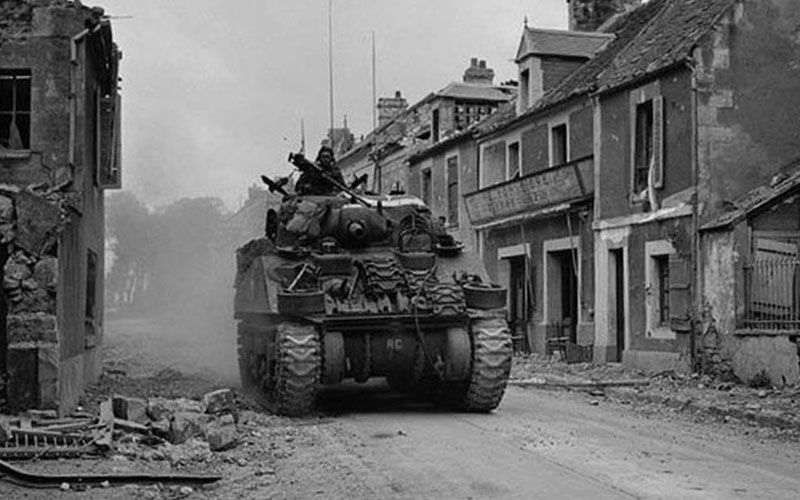
As the time approached 15:00hrs, American troops inland from Omaha hold the town of Colleville-sur-Mer. The German 916th Grenadier Regiment led by Colonel Goth tries to counter-attack and recapture the town, but is unsuccessful.
At 15:30hrs, overlooking the beach at Omaha, Heinrich Severloh, the last German defender of strongpoint Wn62, abandoned his post. He later claimed to have fired over 12,000 rounds with a machine gun and 400 with his rifle, and may be responsible for hundreds of American casualties on the beach below.
Strongpoint Sole between Ouistreham and Colleville-sur-Orne falls to B Squadron 13 Hussars at 15:45hrs, captured by the 2nd Battalion, East Yorkshire Regiment. 40 Germans are captured. Fifteen minutes later, along the coast, Le Hamel is finally captured by 1st Battalion Hampshire Regiment from Gold beach. British armour has also finally reached Arromanches. Meanwhile, along the coast to the west, American armour begins advancing inland from Omaha beach. First Sherman tank reached the road connecting the beach to Colleville-sur-Mer but was destroyed by the Germans.
The British 9th Infantry Brigade which landed at Sword Beach has moved inland. The 185th Brigade repelled an attack by the German 21st Panzer Division at Périers Ridge, but the British advance slowed.
Caen was bombed for the second time during the day in an attempt again to destroy German communication lines. This time the targets were the bridges on the Orne river. Bombing lasted for more than a quarter of an hour, destroying an entire neighborhood. Caen had now suffered many hundreds of civilian casualties.
The battle has begun and France will fight it with fury. For the sons of France, whoever they may be, wherever they may be, the simple and sacred duty is to fight the enemy with every means in their power.
- Charles de Gaulle, Leader Free French Forces (broadcast to the French people)
By 18:00hrs, American forces had liberated Saint-Laurent-sur-Mer just inland from Omaha Beach, whilst British and Canadian forces linked the Gold and Juno beachheads. Allied naval bombardment finally silenced the battery at Longues, whilst the Canadian 9th Brigade reached the town of Bény.
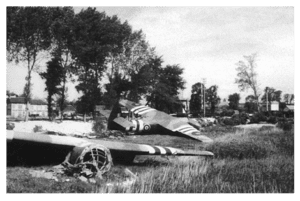
In England Churchill spoke again to the Commons, telling them “I have been at centers where the latest information is received and I can state to the House that this operation is proceeding in a thoroughly satisfactory manner.”
At around 20:00hrs, the German 21st Panzer Division reached Luc sur Mer between Juno and Sword beaches, but British armor and infantry managed to halt their advance. Allied patrols reached the outskirts of Bayeux, whilst Arromanches was captured. This was a critical stage in the preparations for the Mulberry-B artificial harbor – elements of which were already under tow from the UK.
The 1st Suffolk Regiment captured the Hillman fortified site at Colleville-sur-Orne near Sword Beach, which had been the headquarters for the 736rd Regiment Grenadiers.
At 21:00hrs, gliders of Operation Mallard arrived in Normandy. The gliders carried the remaining men and equipment of the 6th Airborne Division, and were escorted across the Channel by fifteen squadrons of fighter aircraft. As it was still daylight, previous navigation problems that had affected the earlier operations were absent. As the gliders approached the two landing areas they met with anti-aircraft fire from German defenders on the ground.
The gliders headed for two landing areas, “LZW” to the east of Saint-Aubin-d’Arquenay and Landing “LZN” to the north of Ranville. The remaining troops of the 2nd Battalion, Oxfordshire and Buckinghamshire Light Infantry and ‘A’ Company, 12th Battalion, Devonshire Regiment landed at LZW. Given the limited availability of aircraft, even two lifts did not provide capacity to transport all of the Devonshire battalion, the rest of whom arrived by sea on D+1. The 6th Airlanding Brigade headquarters, 1st Battalion, Royal Ulster Rifles and the 6th Airborne Armoured Reconnaissance Regiment landed at LZN. The latter were equipped with the Tetrarch light tank – the first time that any tank had been flown into battle by air.
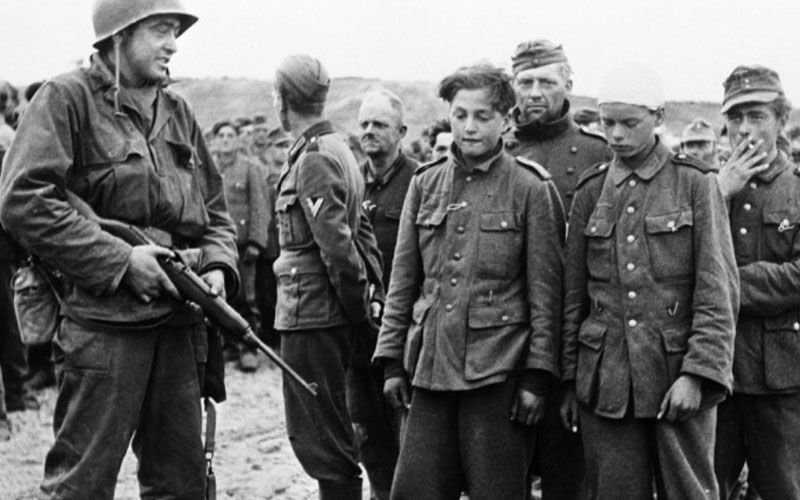
Shortly after sunset, Field Marshall Rommel arrived back at his headquarters in La Roche-Guyon just west of Paris. He had been visiting his wife Lucie at Herrlingen in south-west Germany to celebrate her 50th birthday. On the other side of the Channel, General Montgomery boarded the destroyer HMS Faulknor at Portsmouth destined for Normandy where he will take command of Allied troops. In Normandy, Caen is bombed for the third time that day. Canadian and British forces advancing on the city are stalled at the Bois-de-Lebisay just to the north.
By midnight on D-Day, all of the beaches had been secured, although none of the forces had succeeded in achieving all their objectives. The largest bridgeheads were in the British and Canadian sectors. The Sword beachhead was roughly 6.2 square miles but had been unable to link up with the forces which landed at Juno. The Gold and Juno landings resulted in a pocket approximately 6 miles deep and 9 miles long.
Along the coast in the American sector, the Omaha force held positions at Vierville-sur-Mer, St-Laurent-sur-Mer and Colleville-sur-Mer, creating a beachhead just over a mile deep and about 4 miles long. Airborne troops held scattered areas reaching to about 6 miles inland.
The 6th June 1994 was just one of many “D-Days” during the Second World War, a conflict that would span the globe for more than five years and cost an estimated 56.4 million lives – both military and civilian. The Normandy Landings were an essential springboard from which the Allies could push westward towards Germany and the eventual link up with Soviet forces from the east.
The largest seaborne invasion in history saw 132,700 men ashore by the end of the first day, with a further 23,400-strong force of paratroopers and glider infantry delivered from the air. The invasion front remained vulnerable to German counter-attack, and there was still terrible fighting ahead, but a crucial step had been taken towards liberating Europe.
More Reading:
Read about each of the different landing zones here:
- Utah Beach Landing Zone
- Omaha Beach Landing Zone
- Gold Beach Landing Zone
- Juno Beach Landing Zone
- Sword Beach Landing Zone








































